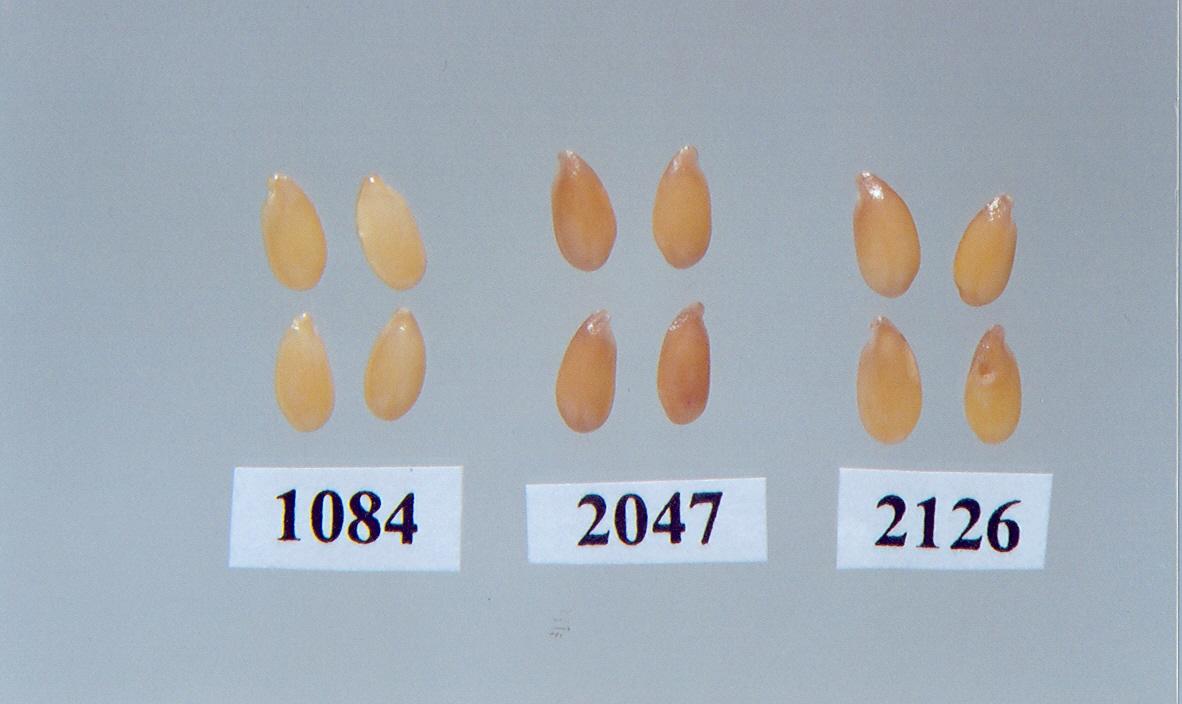2126
| Denomination: | '2126' |
|---|---|
| Botanical Name: | Linum usitatissimum |
| Applicant/Holder: |
Viterra Inc. 201- 407 Downey Road Saskatoon, Saskatchewan S7N 4L8 Canada |
| Breeder: |
J.C. Paul Dribnenki, United Grain Growers Limited, Vegreville, Alberta |
| Agent in Canada: |
Viterra Inc. 2625 Victoria Avenue Regina, Saskatchewan S4T 7T9 Canada |
| Application Date: | 2004-02-23 |
| Application Number: | 04-4056 |
| Grant of Rights Date: | 2007-05-18 |
| Certificate Number: | 2738 |
| Date rights revoked: | 2010-10-04 |
Variety Description
Varieties used for comparison: '1084', '2047' and '2090'
Summary: '2126' has a shorter main axis of the stem at capsule maturity than the reference varieties. The flowering date of '2126' is earlier than the reference varieties. '2126' is lacking ciliation of the false septa of the capsule while in '2047' it is present. The seed of '2126' is slightly darker yellow than '1084' but slightly lighter yellow than '2047'. '2126' has fair resistance to lodging while in '1084' and '2090' it is good. The percent protein content of '2126' is higher than in '1084'.
Description:
FLOWER: flattened disc shape, medium corolla size, absent to very weak sepal dotting, no longitudinal folding of petal, light violet petal colour, filament with blue top and white base, blue anthers, white pollen, style with violet top and blue base, medium violet coloured stigma
CAPSULE: medium size, medium maturity, indehiscent, absence of ciliation of the false septa,
SEED: medium size, medium yellow colour
DISEASE RESISTANCE: moderate resistance to Flax wilt (Fusarium oxysporum f. sp. lini)
AGRONOMY: fair resistance to lodging, medium capability to produce basal branching
USE: oilseed flax variety
Origin & Breeding History: '2126' was developed by United Grain Growers Ltd. by crossing 'SP992' to '94-7889' in 1995 in Morden, Manitoba. 'SP992' was derived from NorMan/Zero//CPI84495/3/NorMan3 and 94-7889 was derived from high oil strains 90-5889/AC McDuff. 90-5889 was derived from NorMan/Zero//CPI84495/3/NorMan2. F2 and subsequent generations were advanced using the pedigree breeding method with selection criteria being seed colour, oil content, fatty acid profile, lodging resistance, disease resistance and agronomics. Single plant selection was made in the F3 and F5 generation. This line was evaluated in replicated field trials in 1999 (5 locations) and in 2000 (8 locations) as 95-25-F9-127-3. The line was evaluated as SP2126 in the 2001-2003 Low Linolenic Flax (Solin) Co-operative Test.
Tests & Trials: Trials were conducted in the summers of 2003 and 2004 in Rosebank, Manitoba. There were four replicates arranged in a RCB design. Each plot consisted of an area of 3 metres x 1.2 metres.
Comparison tables for '2126' with reference varieties '1084', '2047' and '2090'
Plant: length of main axis (cm)
| '2126' | '1084' | '2047' | '2090' | |
|---|---|---|---|---|
| mean | 39.6 | 50.4 | 45.5 | 44.2 |
| std. deviation | 4.3 | 8.4 | 6.4 | 5.4 |
Flowering date (number of days from seeding with 10% of plants with one or more open flowers)
| '2126' | '1084' | '2047' | '2090' | |
|---|---|---|---|---|
| mean | 50.4 | 56.9 | 53.3 | 53.0 |
% Protein content
| '2126' | '1084' | '2047' | '2090' | |
|---|---|---|---|---|
| mean | 47.8 | 43.8 | 50.9 | 45.6 |
Click on image for larger view

Flax: '2126' (right) with reference varieties '1084' (left) and '2047' (center)
Click on image for larger view

Flax: '2126' (right) with reference variety '2090' (left)
Click on image for larger view

Flax: '2126' (right) with reference variety '2047' (left)
- Date modified: